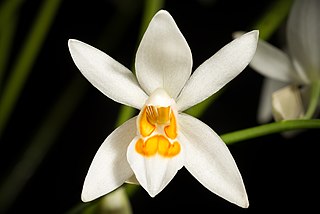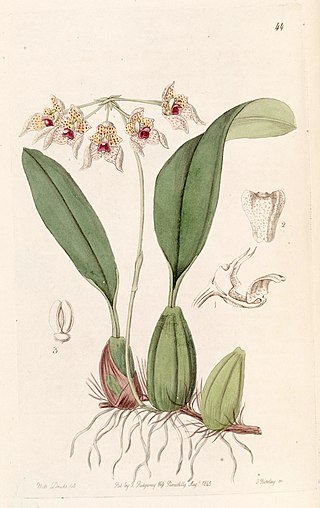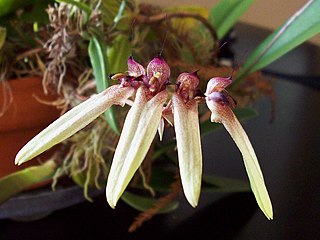
Coelogyne is a genus of 594 species, which are sympodial epiphytes from the family Orchidaceae, distributed across India, China, Indonesia and the Fiji islands, with the main centers in Borneo, Sumatra and the Himalayas. They can be found from tropical lowland forests to montane rainforests. A few species grow as terrestrials or even as lithophytes in open, humid habitats. The genera BolborchisLindl., HologynePfitzer and PtychogynePfitzer are generally included here. The genus is abbreviated Coel. in trade journals.
Black orchid or Black Orchid may refer to:

Coelogyne nitida is a species of orchid in the Coelogyne genus.

Phenanthrenoids are chemical compounds formed with a phenanthrene backbone. These compounds occur naturally in plants, although they can also be synthesized.

Bulbophyllum umbellatum is a species of orchid. It is native to tropical parts of South Asia, from the west central Himalayas to Taiwan and Indo-China.

Coelogyne barbata is a species of orchid. It is a shade-loving orchid that blooms in the months of October–November. It occurs in the Himalayas, Nepal, India, China and Myanmar. It grows epiphytic on trees or lithophyte on rocks in lower montane forests at an altitude of 1000 to 1800 meters above sea level. It is also found in Phalee but is rare. It has long, broad leaves and a bulb stem that grows from the roots. It blooms in September- November. It's a shade loving orchid.

Coelogyne cristata is an epiphytic orchid that comes from cool, moist areas of the eastern Himalayas and Vietnam. It blooms every spring, before the snow begins to melt. Its genus name Coelogyne originates from two Greek words, koilos ("hollow") and gyne ("woman"), because of the orchid's pistil. Cristata takes its species name from crista, the Latin word for "comb", because of the look of the flower's lip.

Coelogyne flaccida is a species of orchid that is native to southeast Asia and northeastern South Asia. Cultivated as an ornamental plant, it is also known as the bearded coelogyne and the loose coelogyne.

Coelogyne lawrenceana is a species of orchid. It is endemic to Vietnam.

Coelogyne xyrekes is a species of orchid.
Bulbophyllum reptans is a species of orchid in the genus Bulbophyllum.
The molecular formula C16H14O5 (molar mass : 286.27 g/mol, exact mass : 286.084124 u) may refer to:
The molecular formula C17H16O5 (molar mass: 300.30 g/mol, exact mass: 300.099773 u) may refer to:
The molecular formula C17H14O6 may refer to:

The Coelogyninae are an orchid subtribe in the tribe Arethuseae.

Coelogin is a phenanthrenoid found in the high altitude Himalayan orchid Coelogyne cristata. This molecule has a phenanthro[4,5-bcd]pyran structure.

Coeloginanthrin is a phenanthrenoid found in the orchid Coelogyne cristata.

Confusarin is a phenanthrenoid found in the orchids Eria confusa and Bulbophyllum reptans. It can also be synthesized.

Bulbophyllum sect. Cirrhopetalum is a section of the genus Bulbophyllum. The taxon name comes from Latin cirrus (fringe) and Greek petalon (petal), hence meaning fringed-petaled.
C. cristata may refer to:














